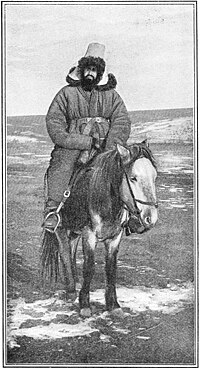Richthofen;[1] (3) to explore the Thibetan plateaus from the point of view of physical geography; (4) to cross Asia from west to east.
"I concluded that this work would occupy not more than two years. My expedition lasted, in fact, three years and seven months. My journey was much richer in results than I had expected, and raised many questions of very great interest. The fund for the expedition was subscribed by the King, Emmanuel Nobel of St. Petersburg, and some other Swedes, and amounted to 30,000 Swedish crowns. I spent, besides, 4,000 kronors which I earned during the first part of my travels by contributing to the newspapers; so that the whole expedition cost 34,000 crowns."
Dr. Hedin's occasional references to details of business are characteristic of the Swedes. They have a strong commercial spirit and a respect for money, but the earning of money is not with them the highest ideal.

A KIRGHIZ SCOUT.
"I started on my journey," continued Dr. Hedin, "on October 16, 1893, and proceeded via St. Petersburg and Moscow to Orenburg, where I bought a tarantass and hired five horses; and with this equipage I crossed the Kirghiz steppes to Tashkent, changing horses at each of the ninety-four stations, and covering the 2,000 kilometers in nineteen days. I remained a month and a half in Tashkent, making the final preparations for my journey, and invested 500 roubles in presents to give to the natives—very bad revolvers, trumpery microscopes, and so on. I reached Margelan, the capital of Ferghana, in February, and on the 25th of that month started out for Kashgar. It was the worst season of the year for crossing the Pamirs, for the snowfall on those mountains is heaviest in February and March, and the danger to caravans is very great. So dangerous was my expedition considered that I could only obtain horses at an exorbitant rate. A horse costs twenty roubles in Tashkent, and I had to pay one rouble a day for each of the twelve horses I hired. The stable-keeper did not expect to see them again, for a snowstorm in the Pamirs kills men and horses. That is why I wanted to go. I wanted to see the snow on the mountains; I had climatical studies to make.
"It took me five days to cross the Alai range, proceeding south over Tengis-Bai pass, the height of which is 3,850 metres. There were no roads. All was snow and ice. We had to cut out roads for the horses. When my five men and myself did not suffice, we hired Kirghises to help us, thirty or forty at times. We crossed very happily; but had we come a day earlier or a day later, we should all have perished. The preceding day an avalanche half a mile in length had fallen, which would have destroyed us utterly. The day after our crossing there was a terrific snowstorm on the pass.
"It was very difficult work to proceed up Alai valley. We had, in places, to hire the
- ↑ A long and very interesting polemic war waged between the two explorers. Prshewalsky claimed to have discovered Lop-Nor; Richthofen declared that, arguing from the old Chinese maps and books, the real lake of Lop-Nor was much further north than the lake discovered by Prshewalsky. This was the Lop-Nor also reached by Bonvalot and Henri of Orleans. Prshewalsky said the Chinese maps and books were wrong.
